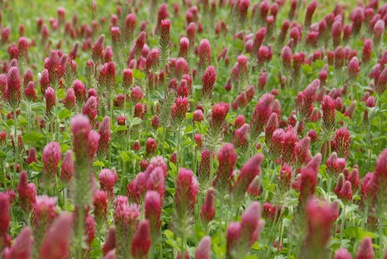Crimson clover is one of North Florida’s best cool season forages. Its feed quality is high and it puts an estimated 100 pounds of nitrogen per acre back into the soil each year, the equivalent of six and a quarter bags of 32% nitrogen.
At a cost of fourteen dollars a bag per bag of nitrogen, that is a value of $87.50 in addition to the value of the grazing. Plus, there’s no additional cost for spreading.
Seed costs for all agronomic crops have increased, and crimson clover seed is no exception. Managing crimson clover to reseed provides an opportunity to minimize the costs of seed and planting.
Recommended seeding rates for crimson clover range from 20-30 pounds per acre. A twenty-five pound seeding rate results in a per acre cost of $37.50. A 2006 report from IFAS estimates variable costs of planting (machinery, labor and fuel) at $21.00 per acre and fixed costs for machinery at $18.60 per acre. (If you can still operate at these costs, you probably should go into custom planting.)
Based on these figures, effective reseeding would reduce production costs at least $77.50 per acre.
This cost savings can be accomplished through grazing management, and as is almost always the case in grazing management, timing is everything. The longer days of April and May make clover plants go to seed and decrease vegetative production. It’s time to act.
Reducing grazing pressure will allow seed to mature. Total removal of livestock until the clover dies back is not required, but reduced grazing pressure is.
Once seed heads begin to dry, pull them through thumb and forefinger. If the seed head strips from the stalk easily, seed are near maturity. Continue to rub the seed head between fingers to determine if the seed separate easily from the dried blooms.
Resume grazing after the clover heads are mature and before the plant has died back. Mature seeds will fall to the ground as well as pass through the livestock in manure. Moving cattle from a field with mature clover seeds into a pasture with no clover will establish clover in the new pasture.Crimson Clover can be managed to reseed, saving money and time for the pasture owner.
In the late summer or fall these pastures should be grazed or mowed closely so the clover seed can compete for light. These small seed have a limited store of energy and need to get to sunlight quickly after germination so the leaves can begin photosynthesis.
Wait until clover plants are eight inches tall before grazing. Remove cattle if the clover gets below four inches in height and wait until it returns to eight inch height before grazing again. This method should sustain the pasture until the same time next year when time for reseeding.
Further information on clovers is available at http://edis.ifas.ufl.edu/ag176 or contact your local Extension livestock agent.


